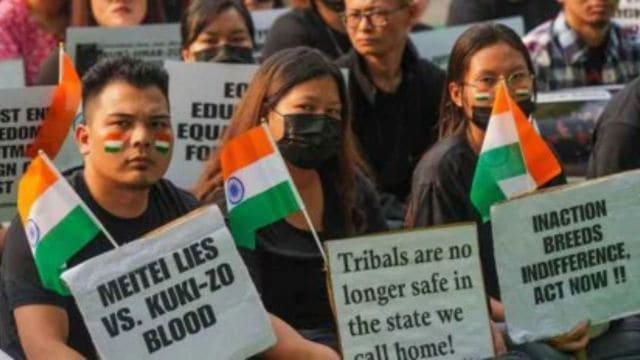
Written by Ranjan Yumnam
When the ethnic violence between the Meiteis and the Kukis erupted on May 3, 2023, in Manipur, this writer, a Meitei IAS officer, was serving as the District Collector of Tengnoupal, a hill district dominated by the Kukis. Tengnoupal was peaceful, and nothing seemed portentous during the early hours of that fateful day. My office ground was, in fact, the final venue of a mass rally led by the CSOs, whose representatives met me and handed over a memorandum addressed to the Hon’ble Governor of Manipur. Accompanying me was the SP, an IPS officer belonging to the Kuki community. We shook hands with the rally leaders, gave speeches, and listened to their grievances in our positions as the heads of the district administration. Ultimately, matters were settled and group pictures were taken — another ordinary day. Little did we, the DC and the SP, know that the communities that we belonged to would be in a war a few hours later. The conflict originated in remote villages bordering a valley and a hill district, Bishnupur and Churachandpur, respectively, after noon — about 80-90 km from my district.
I slept in my official quarters at the district headquarters that night, having decided to visit Moreh, the India-Myanmar border town, the following morning. Everything changed in the morning. The air was communally charged and fatalities were reported on both sides of the sparring groups. Audio-visual clips of horrendous killings, gunshots and hate speeches went viral on social media, offline and in phone conversations. Under the fast-deteriorating law-and-order situation, I was compelled to take my ADM, SDM and Grade IV staff and find a safe hideout-cum-office. We took refuge in the nearby 20 Assam Rifles Camp after trekking hill routes in the cover of darkness in a rescue exercise by AR personnel. We operated from the paramilitary facility for the next 15 days. It felt like a narrow and lucky escape as I witnessed the erstwhile DC complex surrounded by angry locals from the vantage point of my new makeshift office. The rest, as they say, is history.
After approximately 17 months and a death toll of more than 200 people and 60,000 displaced, the conflict has created deep fault lines within the state’s administration, fragmented along the ethnicity of the officers, especially those from All India Services. The officers are isolated and confined to administrative cocoons: Geographical barriers and fear psychosis have killed all keenness for field postings. Venturing outside “safe districts” is akin to suicide in the volatile atmosphere (there are reports of government officials having been killed by mobs). I have encountered these limitations first-hand, and I am sure my colleagues from the Kuki community face similar constraints.
If this abnormality persists, the IAS, IPS and IFS officers will have fewer opportunities for diverse postings, which is essential for gaining field experiences and anthropological insights that will inform their future careers. This doesn’t bode well for the whole cadre as the “steel frame” envisioned by Sardar Vallabhbhai Patel is corroding at its edges, and the noble espirit de corps of its members feels the strain in Manipur.
Hill and valley districts, once accessible to AIS officers, are now divided by “buffer zones”, defeating the federal spirit that underpins the expansive service.
Moreover, interpersonal relationships between officers have become dormant, as light exchanges have been minimised at all levels and overshadowed by the mental malaise of a conflict that saturates public discourse, both online and offline. Hate speech and propaganda from various quarters have further polarised the atmosphere, making collaborations difficult.
The current tensions represent one of the most severe challenges faced by the IAS and other All India Services in Manipur’s history. Given the peculiar challenges, the Manipur experience could also be an opportunity in disguise if it is taken up as a case study for research and documentation by the Lal Bahadur Shastri National Academy of Administration (LBSNAA), Indian Institute of Public Administration (IIPA) and other training institutes for the benefit of its trainees. Original content for new training modules and capacity-building workshops can be tailored, especially in the area of conflict management and reconciliation, enriched by input from officers who have served in conflict-ridden regions like Manipur. These will be equally valuable for academic think tanks studying ethnocentric politics and responses in a democratic framework like ours. A readymade list of practical dos and don’ts for officers posted at challenging places will appeal to many.
Seen optimistically, the much-criticised rigidity and impersonal nature of the Weberian bureaucracy may be leveraged to bring normalcy to the strife-torn state. AIS officers are, foremost, batch mates, agents of national integration and least likely to be radical sectarians plotting in divisive echo chambers (I am occupying the office chamber of a Kuki colleague on loan). As professionals, fraternal feelings will supersede other extraneous factors. This feeling of oneness among the cadre officers symbolises resilience and neutrality that can be harnessed during this conflict, whose fires remain to be put out.
As of today, there’s an opportunity for innovative personnel management policies to engage officers in peace-building efforts. For instance, implementing simple but regular virtual meetings among officers from different ethnic backgrounds can foster unity and bring a semblance of normalcy, at least within the administrative corridors. Such interventions may end the administrative Siberias within Manipur and significantly facilitate the peacemaking process.
The writer is an IAS officer serving as Joint Secretary (Home) for the Government of Manipur
© The Indian Express Pvt Ltd
First uploaded on: 21-10-2024 at 14:18 IST




